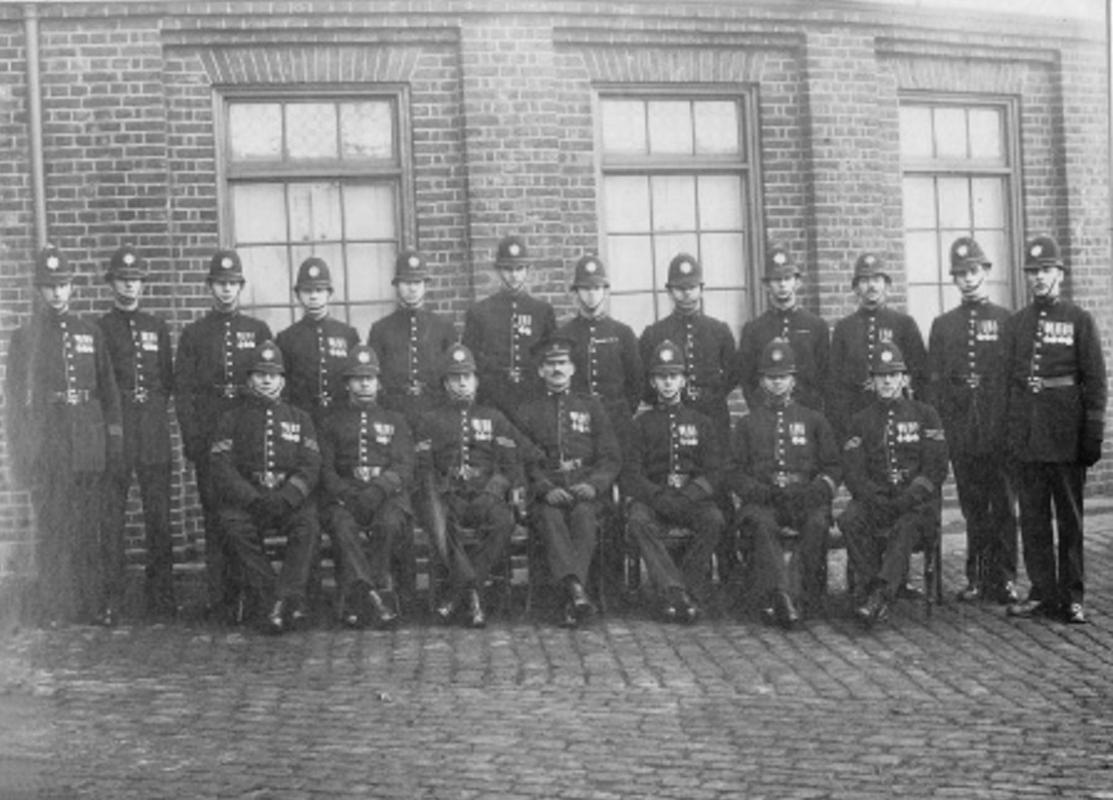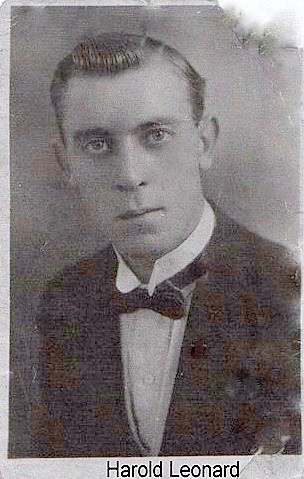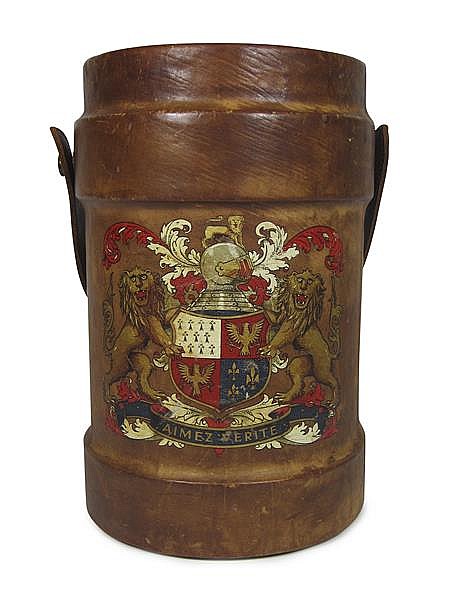-
Posts
76 -
Joined
-
Last visited
Content Type
Profiles
Forums
Blogs
Gallery
Events
Store
Posts posted by Polsa999
-
-
I think the rules on the use of the crown emblem was governed by the Lord Chamberlains office even in Victoria's period. Having researched the history of railway, dock and canal police for a number of years it is obvious that some were allowed to place the crown on their helmet plates because of their service to Victoria......others just did it! I have not yet seen a Victoria crown on any canal police cap/helmet badge. Any evidence of this would be interesting. Steve
0 -
I think that Ross may be close to something in his assumption that this is a badge for a canal policeman. If this is the case then there would be some value in the badge, my only reservation is the use of the crown which would be unlikely but not impossible for a canal company to make use of for its policemen.
0 -
I need some help in explaining the awarding of the medal shown. It appears to have been presented to a civilian who left the Port of Glasgow the following day to the date on the medal to settle in Canada. I can find nothing to indicate why the medal was issued either in the family history or the archives of the British Transport Police History Group, of which I am a research and committee member. Any thoughts or information would be extremely useful as the HG has an enquiry from the grandson of the recipient.
Many thanks
Steve
0 -
Thanks Tony for the response, my question was always going to be a long shot. The officer was in the Regents Canal Dock Police and almost certainly have had no access to Jubilee medals etc. It will be either a campaign or bravery award I think.
Thanks again
Steve
0 -
Hi
I know very little about Campaign medals, however I spend a lot of my time researching the history of railway, dock and canal police. This photo shows a group of medals awarded to a Regents Canal Dock policeman (London). I have a group photo of RCD police and this one may be the officer whose life and death I am investigating. He died under strange circumstances in 1927 whilst on duty at RC Dock, now called Limehouse Basin. This officer was placed in a Barnardo's home around 1913 and then sent to HMS Ganges, in late 1914 he was serving on HMS Hawke when it was torpedoed in the North Sea, after further service in the RN, record attached, he was invalided out in 1920. I have assumed that the middle and right hand medal is the War and Victory medal but have no suggestion as to the medal on the left. The ribbon looks to be all one colour. Can anyone help me please?
Steve
0 -
David McNaughton, born 19 May 1843 in Islington, London. Shown on 1871 census as policeman and living in the Westminster area, having married Mary Ann Beavis on 21st April 1867. Subsequent census showed him as a police constable living in Hanover Square, London area until the 1901/1911 census when he is shown as retired and living in Soham, Cambridgeshire area until his death in the 2nd Quarter of 1930. I think that there may be a descendant or two on Ancestry if you wish to follow up. Steve
0 -
Hi Ross
I think that it was October 1858 that the Bute Dock Police was formed and issued with cutlasses,, although the early docks did have watchmen. It was first headed by Supt. Daniel O'Brien Gavin, a retired military man.
Well done on the find.
Best wishes
Steve
0 -
If you go to the Scottish Police Medals web site...it is mentioned on there.
0 -
The regular Police Long Service Medal was instituted in 1951....this is a George V medal and he died in 1936....so this is probably related to something else, I think the special constabulary....not a medal enthusiast so cannot comment with authority. Steve
0 -
Both officers appear to be wearing the Queen Victoria Jubilee Medal and clasp which indicates that they were present at the 1887 and 1897 parades in London. It is probable that the other medal is for the King Edward VII coronation in 1902. I suspect that either the photographs were taken to commemorate the officers retirement after 1902 or the award of the coronation medal. As you are probably aware, the Met identified their officers by a warrant number which remained the same throughout their service, divisional letter/numbers remained with the officer only whilst they remained on that division.
Although there are people out there who can research police order, rolls etc. NL is correct in that usually visiting the Friends of the Met History website and paying a fee for records check will probably reveal the information which you require.
Or you can purchase - THE METROPOLITAN POLICE THE MEN AND THEIR MEDALS by J Kemp
0 -
A similar question was raised on 25 the April 2014 on this site and there is a comprehensive answer which you may find useful?
Steve
0 -
He once displayed a kindness to me that I will never forget.....RIP, you can stand down, your duty has been done.
0 -
Hi Mike
I know nothing about truncheons, my field of expertise lies with photographic images of railway, dock and canal police. However I take my hat off to you for your analytical process and your conclusion seems perfectly sensible to me!
0 -
Thanks Mervyn and Peter for your assistance and advice. Checking with the Met, I am told that no records of inquests for that period or information of the investigation exist. Checked with the Coroners Office and the London Metropolitan Archives with no success.
I will keep this enquiry on the back burner as I am convinced that there was more to this death than was publicly reported.
Best wishes
Steve
0 -
Thanks Mervyn......it is indeed a complex subject....maybe I was just looking for reassurance that there was no other places to look. A few days ago I was at the National Archives checking the records of the Regents Canal Dock Company. It is extremely strange that there is no reference within those records to the death.
0 -
I think B Division was Barbican, which was bombed and destroyed in WWII. Used to be somewhere where the Barbican Centre is now. Sorry that's all I remember.
0 -
post-13074-0-08543200-1414265741.jp post-13074-0-62651800-1414265706.jpgI am researching the death of a Regents Canal Dock Police Constable on the 30th November 1927. Regents Canal Dock is located in Limehouse, East London and is now known as Limehouse Basin a marina and surrounded by luxury flats. Ships entered the dock from the Thames and items were either directly loaded onto barges or stored in any one of several warehouses which surrounded the dock. Conversely goods were brought into the dock via the Regents Canal or the River Lee for loading onto sea going vessels. In the Victorian and Edwardian periods it was an extremely busy place, crime was a constant companion.
Leonard Harold Wetherall had been a RCD constable since being demobbed from the Royal Navy in 1919. The weather was damp and cold that evening when he was on a late turn duty. He was found dead at the bottom of a warehouse well (through which goods were lifted/dropped by crane) when a search was started after he failed to book off.
The inquest a few days later recorded an accidental death, although the coroner felt that the death was mysterious as the officer had left his own beat crossed a number of barges, a pipeline and climbed some steps to enter the warehouse. The matter was investigated by a local detective.
The grandchildren of Leonard tell me that the family always believed that the death was as a result of a criminal act, but had no proof.
The coroners papers have been destroyed.
The newspaper reports provide nothing useful.
The Met no longer have a record of the incident.
There is nothing on the internet.
I will be checking the records of the RCD Company, held at TNA.
I am trying to locate descendants of his colleagues to establish whether anything has been passed down.
Any suggestions as to what else I can do?
The group photograph is of RCD Police and may have been taken after the funeral of PC Wetherall.
The second photograph is of Leonard.

 0
0 -
Hi Ross
Found this item for sale, described as a 19th century leather cordite bucket...same coat of arms, there also a large number of items on ebay and at other auctions with the same coat of arms but sadly no indication of where the arms are from....
 0
0 -
Dave/Robert
I am afraid that a definitive answer to the question raised by Robert is, as suggested by Dave, not an easy one to answer. These various HP's were issued between 1948 and 1962 and a previous entry contains a reply from one of my colleagues in the BTP History Group, which may provide some answer. The Group has not yet begun a uniform project which would include HP's. The difficulty arises from the many railway police forces which were in existence prior to 1922. Some HP's had crowns some not...some had crowns and later had them removed...a lot of work is needed to discover the correct timeline(s).
Those plates with the griffin were worn by the London Transport officers of the BTC Police.
Regards
Steve
0 -
Well done Tim.....getting started is easy...its stopping thats a problem!!!! Now I know nothing about truncheon's but it sounds like it comes from the Royal Woolwich Dockyard (WD), it established its own police force in 1834 to counter corruption in the detection of theft and idleness. This had been subsumed into the Metropolitan Police in 1841 and in 1846 comprised a force of thirty-nine men, of whom twenty lived on site. I am sure that someone on here will provide further information.....if you are lucky it could be from the original dock force cos I'm not sure if the Met had such fancy truncheons?
The other thing is about Hebbert & Co was that there were three Hebbert & Co. first is Isaac Hebbert & Co 1827-1828, later was Hebbert & Co Ltd 1829-1832, then Isaac Hebbert & Co Ltd 1833 -1852.
So if you know the makers name format, that may also help the experts on here as they were military sword makers for a very long time.
From 1827 they described themselves as Army Accoutrement & cap makers
1843 - Army Clothier
1863 - Army Clothier, cap and accoutrement maker
1887 - Army, Police & Railway clothier, Contractors Contracts & Accoutrement maker
1893 - 1899 - Army, Police & Railway clothier, Contractors Contracts & Accoutrement, cloth cap and helmet makersGood luck. - Steve
0 -
Thanks Alex....for taking the enquiry that bit extra.....now all I ask is that you provide the complete history of the LGOC Police please. LOL!
Steve
0 -
Thanks Alex.....greatly appreciated.....I checked the Old Bailey web site and after you have confirmed that he was E Division, I now know that he was involved in a case of arson as E 397 on 9th January 1888. Many thanks once again.
Steve
0 -
Some of you may know, that along with one or two others on here, I am a volunteer researcher with the British Transport Police History Group.
Recently one of my colleagues completed the first stage of a project to identify the constituent forces of the present day British Transport Police, so far 237 forces have been identified and evidence discovered to prove their existence. These include railway, dock and canal police and, even considered by the project manager to be strange, the police force for the London General Omnibus Company.
Over the last few days, the great grandson of one of these officers contacted our History Group and gave information about John Charles Grimwood who was one of their Inspectors. He also sent us a scan of a remarkable group photo of some 120 officers of the force taken in 1921.
We know that John Charles Grimwood was a Met PC from the 1891 census and living in Bloomsbury, London. From the 1901 census he was a PS living in Camberwell. On the 1911 census he was a police pensioner and lived in Hampstead. He was born in 1866 in Lincolnshire.
We have told our informant, who lives in Australia that we would provide further information.
Is anyone able to help with his Met Police history please?
Thanks
Steve
0 -
Odulf is probably correct, as the medal - not being awarded by the monarch - would be worn on the right chest. The difficulty in viewing the medals details does not help but it does look like the ribbon is of a plain colour.
Therefore this could possibly be the Royal Humane Society Bronze Medal which was introduced in 1837.
You can check out their website, look at the images and make your own mind up? -www.royalhumanesociety.org.uk
Apparently they have a link to a list of recipients, which may assist.
Good luck
0





.thumb.jpg.16e3019f6cbdc230fb5400d461eb6606.jpg)
wots this badge?
in Great Britain: Mervyn Mitton's British & Colonial Police Forces
Posted
I do not propose that we spend too much time on the point since raised. The history of the railway, dock and canal police is not simple. Until the 20th century there was no primary legislation (BTC Act 1948) providing railway companies with the authority to appoint constables so most were appointed under special constable acts. The Great Western Railway police and the Great Eastern Railway police were granted, by royal prerogative , the right to place a crown on their plates....when the GER amalgamated with the LNER in 1923 that right was removed. It may be a surprise to some that many railway police forces such as the North British Railway and the London, Brighton & South Coast Railway police did not swear their constables in until the Edwardian period and they changed their rules and some forces did not swear constables in until they had served a probationary period. You will find that legally the current BTP officers, despite their public facing duties, are not Crown servants but contracted emplyees of the railway. I think that the matter can rest now.